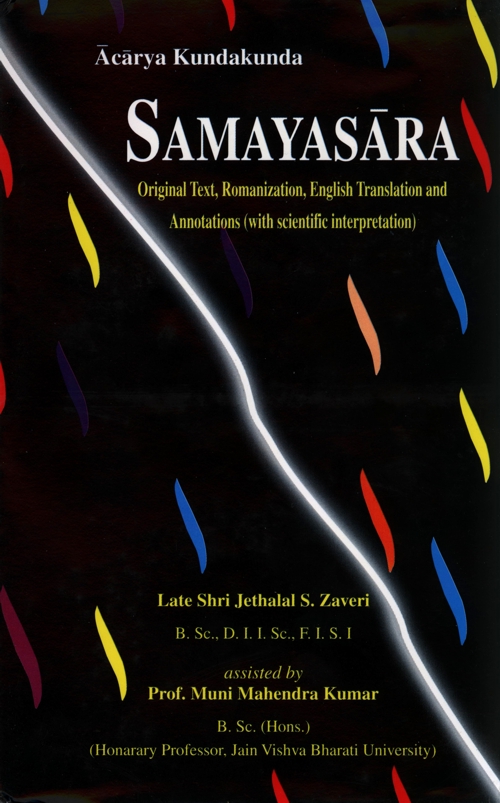Various Misconceptions and (False) Beliefs about Jῑva

appāṇamayāṇaṃtā mūḍhā du parappavādiṇo keῑ.
jῑvaṃ ajjhavasāṇaṃ kammaṃ ca tahā parūviṃti.. 1

avare ajjhavasāṇesu tivvamaṃdāṇubhāvagaṃ jῑvaṃ.
maṇṇaṃti tahā avare ṇokammaṃ cāvi jῑvo tti.. 2

kammassudayaṃ jῑvaṃ avare kammāṇubhāgamicchaṃti.
tivvattaṇamaṃdattaṇaguṇehi jo so havadi jῑvo.. 3

jῑvo kammaṃ uhayaṃ doṇṇi vi khalu ke vi jῑvamicchaṃti.
avare saṃjogeṇa du kammāṇaṃ jῑvamicchaṃti.. 4

evaṃvihā bahuvihā paramappāṇaṃ vadaṃti dummehā.
te ṇa du parappavādῑ ṇicchayavādῑhi ṇiddiṭṭhā.. 5
(Keyῑ mūḍhā du) Some perverted ignorant people (appāṇamayāṇaṃtā) not being aware of the (real) nature of self, (parappavādiṇo) and mistaking alien objects as the self (parūviṃti) believe and put forward that (ajjhavasāṇaṃ tahā ca kammaṃ) emotions and passions [such as attachment etc.] and karma comprise (jῑvaṃ) the soul.
(Avare) Some others (maṇṇaṃti) believe that (ajjhavasāṇesu tivvamaṃdā āṇubhāvagaṃ) high and low intensities of the emotions and passions (jῑvaṃ) comprise the soul; (avare) still others (ṇokammaṃ cāvi jῑvotti) identify the body as the soul.
(Avare) Still others (kammassudayaṃ jῑvaṃ) believe that the fruition of karma (karmaphala) is the soul and some others believing that (tivvattaṇa maṇdattaṇa guṇehi so jῑvo havadi) the difference between the high and low intensities qualify the soul (kammaṇubhāgaṃ icchaṇti) put forward that the strength of the fruition of karmaḥ is the soul.
(Ke vi) Others still (jῑvo kammaṃ uhayaṃ doṇṇivi) believe that the composite of the jῑva and karma both (khalu jῑvamicchaṇti) comprise the self; (avare du) while some others (kammāṇaṃ samjogeṇa jῑvamicchaṇti) believe that the self is the result of association of karma.
(Evaṃvihā bahuvihā) Thus, there are these and various other [false] beliefs among (dummehā) perverted people who (paraṃ appāṇaṃ vadaṃti) believe and declare the alien objects as self; (te na paramatthavādi) such absolutists are ignorant of the ultimate truth (ṇicchayavādῑhi ṇiddiṭṭhā) according to the [non-absolutist] believers of ultimate truth and reality (niścayavāda).
Annotations:
India is the land of spiritualism where spiritual convictions and a constant urge for ultimate truth inspired the manifold branches of Indian thought. Spirit or soul is, thus, the central figure and the common ground among the different systems is the belief in the intrinsic purity of the soul. But in worldly existence the soul is enveloped by an inanimate environment and there is continual interaction between the soul and the matter. In particular the organic unity of the non-material soul and the physical body in actual life gives rise to various unverifiable conceptions and beliefs regarding the real nature of the soul/self.
As stated earlier Jains believe that the truth is free from all absolutism. But other philosophical systems do not accept the non-absolutist realism of Jains. The conceptions and beliefs put forward by them may be perfectly legitimate from some aspects, but by asserting that what they believe is the whole truth, they commit a gross logical fallacy.
In the above verses, Ācārya Kundakunda describes some of the conceptions regarding the real nature of soul/self as asserted by various schools of thought. Later on, in this chapter, Ācārya himself will concede that some of these conceptions are perfectly legitimate, if they are put forward as working hypotheses for corelation of the body and the soul and can be accepted to be valid from certain empirical aspects. However, if they are asserted as absolute truth, they certainly fall in the category of misconceptions and false beliefs.
(Mis) conceptions mentioned in the above verses are:
- Adhyavasāya is the self: Adhyayasāya means emotional afflictions such as attachment & repulsion. They are produced by the fruition of the deluding karma. When this karma is destroyed there is neither attachment nor repulsion. Hence emotions cannot be identical to the soul.
- Karma is the self: Karma is karmic matter or the subtle body which is an appendage of the soul. It can be totally destroyed by spiritual discipline, and hence, cannot be identified with the soul.
- Degrees of emotions is the self: Since the emotional afflictions themselves are the result of fruition of karma, their intensities or degrees cannot be different from them, and hence, they cannot be identified with the self.
- Nokarma is the self: Nokarma is the gross physical body. On death it perishes and is separated from the soul. Hence, it cannot be the self.
- Fruition & intensity of fruition of Karma is self: Fruition & intensities of fruition of the karma are not basically different from karma, and hence, cannot be identified with the self.
- Composite of karma and the soul is the self: This, of course, is the condition of worldly life. But since karma can be totally demolished, the composite cannot be identified with the self.
- Association of karma is the self: Similarly association of karma is not identical to the self.
 Jethalal S. Zaveri
Jethalal S. Zaveri
 Prof. Muni Mahendra Kumar
Prof. Muni Mahendra Kumar

